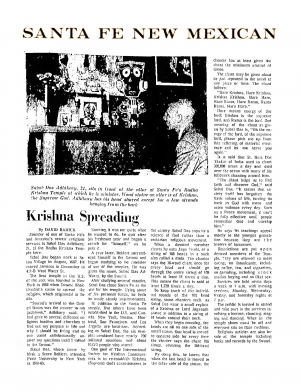Krishna Spreading
This article "Krishna Spreading," was published in The Santa Fe New Mexican, April 21, 1968, in Santa Fe, New Mexico.
By DAVID RARICK
Minister of one of Santa Fe's and America's newest religious services is Subal Das Adhihary, 21, of the Radha Krishna Temple here.
Subal Das began work in Seton Village in August, 1967. He moved services in December to 411-B West Water St.
The first temple in the U.S. of sect was founded in Now York in 1966 when Swami Bhaktivedanta came to spread the religion, which originated in India.
"Swami's arrival to the United States was the answer to my problems," Adhikary said. "I had gone to several different religious leaders and churches to find out my purpose in life and why I should be living and no one could satisfactorally answer my questions until I talked to the Swami."
Subal Das, whose name hy birth is Steve Bohlert, attended Pratt University in New York in 1961-65.
Knowing it was not quite what he wanted to do, he quit after his freshman year and began a search for "himself," as he puts it.
A year later, Bohlert surrendered himself to the Swami and began studying to be minister of one of the temples. He was given the name, Subal Das Adhikary, by the Swami,
After studying several months, Subal Das chose Santa Fe as the site for his temple. Using some of his personal funds, he feels he made steady improvements.
In addition to the Santa Fe temple, five others have been established in the U.S. and Canada. New York, Boston, Montreal, San Francisco, and Los Angeles are locations. According to Subal Das, the six temples combined have nearly 200 initiated members and about 10,000 people who attend.
One goal of The International Society for Krishna Consciousness is to re-establish Krishna (Supreme God) consciousness to the society Subal Das says its a science of God rather than a sectarian religious movement.
When a devoted member chants he uses Jaya beads, or a string of 108 beads in a sack also called a Mala. The chanter says the 16-word chant once for every bead and should go through the entire string of 108 beads at least 16 times a day. This means the chant is said at least 1,728 times a day.
To keep track of the individual rounds of the 108 head string, some chanters such as Subal Das wear a small replica of a Krishna or Lord Jaganath statue in addition to a string of 16 beads around their neck.
When they begin counting, the beads are all on one side of the small statue. One bead is moved to opposite side for every time the chanter says the chant 108 times, covering the 108-bead string.
By doing this, he knows that when the last bead is moved to the other side of the statue, the chanter has at least given the chant the minimum amount of times.
The chant may be given aloud or just repeated in the mind at any place or time. The chant follows:
"Hare Krishna, Hare Krishna, Krishna Krishna, Hare Hare, Hare Rama, Hare Rama, Rama Rama, Hare Hare."
Hare means energy of the lord; Krishna is the supreme lord, and Rama is the lord. One meaning or the chant as given by Subal Das is, "Oh the energy of the lord, of the supreme lord, please pick me up from this suffering of material existence and let me serve you again,"
It is said that St. Hari Das Thakur of India used to chant 300,000 times a day and died near the ocean with many of his followers chanting around him,
"The chant helps us to find faith and discover God," said Subal Das. "It seems that society itself has forgotten the basic values of life, turning its back on God with more and more violence every day. Such as a Peace movement, it can't be fully effective until people remember God and worship him."
He says its teachings appeal mostly to the younger generation because they are the leaders of tomorrow.
Restrictions are put it upon devoted members of the Temple. They are allowed no meat eating, no intoxicants, including coffee, tea, and cigarettes, no gambling, including stock market buying and no illict sex.
Services are held seven days a weak at 7 a.m. with evening services, Monday, Wednesday, Friday, and Saturday nights at 7 p.m.
The public is invited to attend and to take part in the services involving a lecture, chanting, singing and dancing. When in the temple shoes must be off and everyone sits on floor cushions.
Religious articles are also for sale at the temple including books and records by the Swami.
Photo: Subal Das Adhikary, 21, sits in front of the altar at Santa Fe's Radha Krishna Temple at which he is minister. Wood statue on altar is of Krishna, the Supreme God. Adhikary has hits his head shaved except for a few strands hanging from the back.
